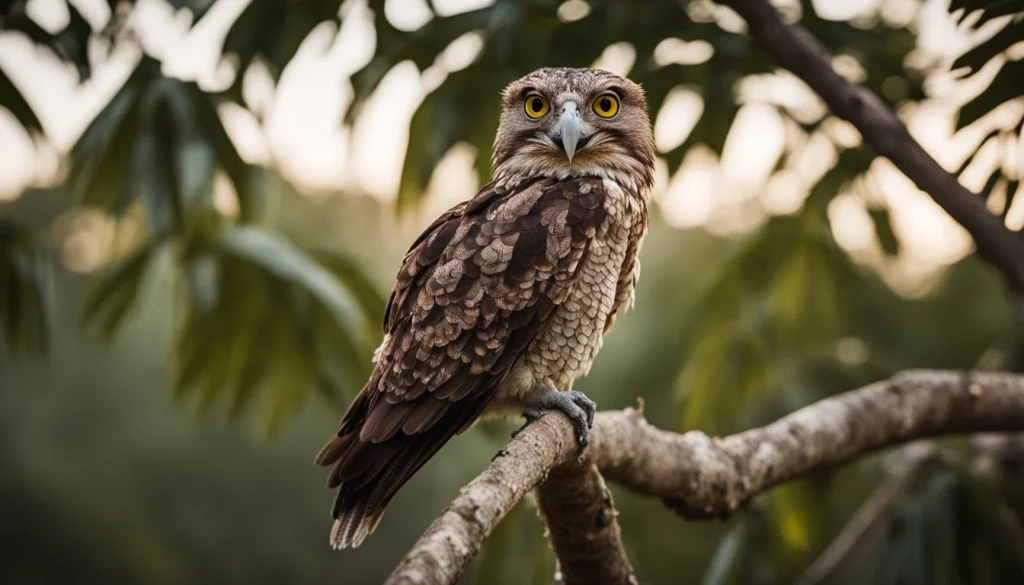The Potoo is one of the most peculiar and mysterious birds in the world. With its unique appearance, strange behaviors, and incredible camouflage abilities, this bird often goes unnoticed by even the most observant birdwatchers. Found in Central and South America, potoos belong to the family Nyctibiidae and are related to nightjars. Despite their bizarre looks, they are remarkably adapted to their environments. Here are seven fascinating facts about this elusive bird.
1. Masters of Camouflage
One of the most remarkable features of the potoo is its ability to blend seamlessly into its surroundings. With mottled gray, brown, and white feathers, potoos are perfectly camouflaged against tree bark, where they perch during the day. They remain incredibly still, often posing like a broken tree branch, making them nearly impossible to spot.
Their incredible camouflage is a primary defense mechanism against predators. By staying motionless and relying on their cryptic coloring, potoos avoid detection while resting during daylight hours.
Camouflage Abilities:
- Feather Coloration: Mottled gray, brown, and white patterns help them blend into tree bark.
- Immobile Posture: They adopt a pose resembling a tree stump or broken branch to avoid predators.
2. Huge Eyes for Night Vision
Potoos are nocturnal birds, meaning they are most active at night. To help them hunt in low-light conditions, potoos have large, round eyes that give them excellent night vision. Their eyes take up a significant portion of their head, which is crucial for spotting insects and other prey in the darkness.
Interestingly, even when their eyes are closed, potoos have small slits in their eyelids that allow them to detect movement, ensuring they remain alert to potential threats even while they appear to be resting.
Eye Adaptations:
- Large Eyes: Optimized for night vision, helping them hunt in the dark.
- Eyelid Slits: Allow them to detect movement without fully opening their eyes.
3. Bizarre, Wide-Mouthed Appearance
Potoos are known for their distinctive, wide-mouthed appearance, which makes them look almost comical. Their large, gaping mouths are perfect for catching flying insects, which make up the majority of their diet. At night, potoos perch on branches and use their wide mouths to scoop up moths, beetles, and other insects as they fly by.
This unique hunting strategy allows them to be effective aerial hunters while using minimal energy. The bird’s broad bill and massive gape make it perfectly suited to catching prey mid-flight.
Feeding Adaptations:
- Wide Mouth: Ideal for catching flying insects like moths and beetles.
- Aerial Hunting: Perches on branches and snaps up prey mid-air.
4. Potoos Are Solitary and Secretive
Unlike many birds that live and hunt in flocks, potoos are generally solitary creatures. They are secretive by nature, and their solitary lifestyle helps them remain unnoticed by predators and humans alike. Their eerie, mournful calls can sometimes be heard echoing through the forests at night, but spotting one in the wild is incredibly rare.
Their secretive behavior, combined with their exceptional camouflage, makes potoos difficult to study, and much about their lifestyle remains a mystery to ornithologists.
Behavior:
- Solitary: Potoos live and hunt alone.
- Secretive: Rarely seen by humans, known for their eerie, nighttime calls.
5. Seven Species of Potoo
There are currently seven species of potoo, all of which are found in Central and South America. Each species has its own distinct size and coloring, but they all share similar behaviors and characteristics. Some of the most well-known species include the Great Potoo (Nyctibius grandis), the Common Potoo (Nyctibius griseus), and the Northern Potoo (Nyctibius jamaicensis).
These birds inhabit a variety of tropical and subtropical environments, from dense rainforests to more open woodland areas, but their secretive nature makes them difficult to track.
Species:
- Great Potoo: The largest of the species.
- Common Potoo: Widespread across Central and South America.
- Northern Potoo: Found in the Caribbean and parts of Central America.
6. Unique Vocalizations
Potoos are famous for their eerie, haunting calls, which are often described as melancholy or ghostly. Their calls, which are most commonly heard at night, have earned them nicknames like “ghost birds” or “night spirits.” Each species of potoo has its own unique vocalizations, but they generally produce a series of deep, moaning, or wailing sounds that echo through the forest.
These calls are not only used to communicate with potential mates but also to establish territory and warn off other potoos.
Vocalizations:
- Eerie Calls: Known for their haunting, melancholy sounds.
- Communication: Used for mating and territory defense.
7. Single Egg Laid on Bare Branches
Unlike most birds that build elaborate nests, potoos are incredibly minimalist when it comes to nesting. They lay a single egg directly on a bare tree branch or in a natural crevice in the bark. The egg is camouflaged against the bark, much like the bird itself, and both parents take turns incubating the egg.
Once the chick hatches, it remains with its parents for several months, during which time it is fed and protected. Potoo chicks are born with similar camouflage as the adults, helping them blend into the tree branch as they grow.
Nesting Behavior:
- Minimal Nesting: Lay a single egg on a bare branch or crevice.
- Camouflage: The egg and chicks are well camouflaged to avoid predators.
Conclusion
The potoo is an extraordinary bird with fascinating adaptations that allow it to thrive in the tropical forests of Central and South America. From its masterful camouflage to its wide-mouthed feeding strategy, the potoo is a true marvel of evolution. Despite its strange appearance and eerie calls, this elusive bird plays an important role in the ecosystem as a nighttime insect hunter. The more we learn about potoos, the more they continue to amaze us with their unique behaviors and characteristics.
FAQ
What do potoos eat?
Potoos primarily feed on flying insects, such as moths, beetles, and other nocturnal insects.
How many species of potoos are there?
There are seven species of potoos, all found in Central and South America.
Why are potoos so hard to spot?
Potoos are incredibly difficult to spot due to their perfect camouflage and motionless behavior, which makes them blend into tree bark.
Are potoos related to owls?
While potoos may look similar to owls because of their large eyes and nocturnal habits, they are actually more closely related to nightjars.
What is a potoo’s call like?
Potoos are known for their eerie, ghostly calls, which sound like mournful moans or wails, often heard at night.
How do potoos protect their eggs?
Potoos lay a single egg on a bare branch or in a natural crevice, and both parents take turns incubating it. The egg is camouflaged to blend in with the tree.


